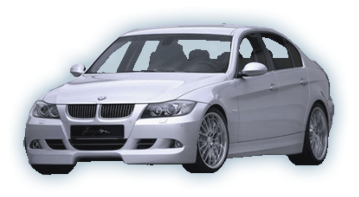

BMW 3 Series (E90) 2006-2011
Overview
The E90 has broad appeal being BMW's highest selling model, and being the highest selling luxury car in the US and Canada, with numerous body style and engine choices it is a very flexible car that offers a wide range of performance levels including even the M3 which is based on the E90. To accommodate such a wide variety of roles the E90 is equipped with a fully independent suspension including aluminium MacPherson struts in the front, and steel 5-link Multi-link suspension in the back. Front brakes have much more stopping power than rear brakes, and one feature of the E90's suspension is to allow very large, high performance front brakes. Also, the use of steel designed to provide high strength for casting applications allowed BMW to greatly reduce the weight and cost of the rear suspension, in addition, the rear axle can be completely pre-assembled and adjusted with the brake system and suspension.
E46 comparison
The E90 saloon is 49 mm (1.9 in) longer, 78 mm (3.1 in) wider and 9 mm (0.4 in) taller than its predecessor (E46). The wheelbase is longer by 35 mm (1.4 in). In previous 3 Series models, space for passengers and luggage were common criticisms; however, BMW made significant improvements to the poor leg and headroom in those previous models. BMW's brochure even highlights, 'Now long legs can be enjoyed even by the people who have them'. Large amounts of aluminium were used in the body work and suspension in an attempt to keep the weight close to previous models; however, the E90 weighs between 50 lb (23 kg) and 300 lb (140 kg) more than comparable older models. The N54B30 engine is all aluminium with cast-iron liners, while the N51 and N52 engines largely consist of aluminium with an outer shell of magnesium and even aluminium bolts to prevent corrosion from dissimilar metals. The cylinder sleeves in N54 are steel and have copper coating, while N52 have Alusil aluminium sleeves.
The E90 also introduced run-flat tires to the 3 Series range. Consequently, cars with run-flats are not equipped with a spare tire. While these theoretically improve performance and handling, run-flats sometimes cost more to replace and can give a harsher ride.
Body styles and models
Body styles and models
Salon (E90)
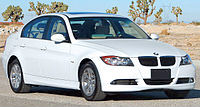
Pre-facelift BMW 325i (E90), US
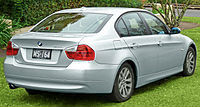
Pre-facelift BMW 320i (E90), Australia
The salon model was the first model sold of the 5th generation BMW 3 series. Debuting in the US in 2005 as a 2006 model, the E90 came in two trims, the 325i/xi and 330i/xi models. Later, the 3 Series lineup received an engine boost with the debuts of the 2007 328i/xi and 335i/xi models, the 335i/xi receiving the new 3.0L twin-turbo inline-6 engine.
With the introduction of the pre face-lifted 2006 E90 body style we see an evolution to a more modern car with sharp lines, edgy corners, and a contemporary interior. The new 3 series has proved not to be as controversial as redesigns of the 2002 E65 7 Series, and 2004 E60 5 Series, possibly due to the fact that it is BMW’s top selling model. Most of the round corners, and traditional interior of the (E46) is replaced with sharp edges. This is evident in a sharp line running across the dashboard, a long crease spanning the length of the car running through the door handles, and sharp edges in the bumpers, and side skirts. The turn signal lamps are now housed in the same unit as the head lamp. The top of the kidney grills has two flat pieces of chrome attached to the hood. Side view mirrors are no longer tinted blue and have changed to an oval shape. The arch of the roofline is not quite as symmetrical as the (E46) and is slightly flat on top. The rear end (trunk boot, rear bumper, tail lamps) has taken on the controversial shape of a “bangle butt”. Tail lamps are now red, and no longer have amber turn signals; side markers and front turn signal lamps are now clear and not amber. Mid-range (330i/335i) models have chrome inserts in the kidney grills, a chrome strip outlining the side windows, 1-inch-larger wheels on sport models, and "angel eye" bi-xenon HID projector headlamps; base models (325i/328i) lack these minor exterior upgrades.
The interior has sharp lines running across a boxy dashboard. A wide rectangular piece of trim runs across the dashboard which encloses the A/C vents. Push button ignition with a key fob has replaced the traditional turn-key ignition. The center consol contains a swooping piece of trim with ash tray inserts that runs from the arm rest to the dashboard. Radio/climate control is intergraded into a more boxy frame. Optional I-drive is now housed flush in the top of dashboard. Two somewhat flimsy pop-out cup holders protrude out of the passenger side of the dashboard. The door panels have a-symmetrical lines; the door trim has moved to below the leather-stitched arm rests that swoop downward. Window/Lock buttons have moved from the center consol to the doors for front occupants. Aluminum Door handles have taken on a twisted and contemporary shape. Cruise control buttons have been moved from the steering wheel face to a stalk behind it.
The Canadian 3 Series followed the US very closely, and also had an additional trim in the entry-level 323i RWD saloon, which takes over from the 1997 BMW 320i (E36) and its 168 hp 2.2-litre inline six, which was in turn preceded by the 1997 BMW 318i 138 hp (103 kW) inline four.[16] Its 2.5L inline-6 engine produced 174 hp for the 2006 model year and then 200 hp for 2007 onwards. With an MSRP of $35,200 for the 2006 model year, the 323i is priced the same as the BMW 128i, making them the least-expensive vehicles in the BMW Canadian lineup. As the base model in 3 Series lineup in Canada, the 323i does not have available or optional; Xenon headlamps, fog lights, automatic climate control, power-adjustable seats, navigation, premium audio, and Dakota leather upholstery. The 323i also only has a six-speaker audio system and 16-inch alloy wheels. The 2006-7 model year 323i did not have an engine block heater available—though one can be retrofitted—without this ignition in extremely cold weather are problematic. The 323i received fog lamps for 2008, automatic climate control for 2009, and 17-inch alloy wheels for 2010. Amenities like a glass sunroof, heated front seats, Bluetooth, and USB input are options on the 323i that are standard on the more expensive 3 Series trims. Facing heavy competition from the more-recently refreshed Audi A4 and Mercedes-Benz C-Class, BMW Canada released the 2011 BMW 323i Luxury Edition with an MSRP of $37,650, including $3,500 of upgrades including automatic transmission, 17-inch alloy wheels, electric front seats, Bluetooth and USB compatibility, and an electric glass sunroof.
BMW released an M3 variant of the E90 saloon for the 2008 model year. The M3 saloon features the same V8 engine and transmission as the M3 Coupe and Convertible. The M3 saloon uses the E92 coupe's front fascia and bumper intakes, which is different from the other E90 saloons (including non-M saloons with the M Sport package).
Oxidized Aluminum Kit
The oxidized aluminum kit is for BMW, Jaguar, Mercedes, Volvo, Saab, Volkswagen, and many others. This flexible deoxidizer lasts indefinitely. After the surfaces are prepared following the directions on the included DVD, the deoxidizer is applied with the applicator using a flow on motion. The oxidized look immediately disappears, leaving an original factory look.
The kit includes all materials necessary to achieve a professional end result.
This Kit is:
$49.95 Plus $10.00 Shipping.
We offer a 30 day money back guarantee.
BMW 3 Series (E90)
he BMW E90 series is the fifth generation of the BMW 3 Series range of compact executive cars, including sedan, station wagon (designated as E91, marketed as Touring), coupé (E92) and coupé cabriolet (E93) configurations. A high-performance BMW M3 version of the E90, E92, and E93 is also available. The E90 family succeeds the E46 model, and was launched in March 2005.
In 2002, Norbert Reithofer and Development Chief Burkhard Goeschel started an initiative to halve the time it took to reach full production of the next generation 3-series from six months to three. First marketed in March 2005, the car quickly became BMW Group's best-selling automobile worldwide, and by the end of the year 229,900 vehicles had been delivered. It is by far the best-selling entry-level luxury car in Canada and the United States.
In 2008, the saloon underwent an extensive mid-cycle facelift. In 2010, the coupe and convertible were facelifed as well. Facelifted 3-series are commonly referred to as "LCI" (Lifecycle Impulse) models.
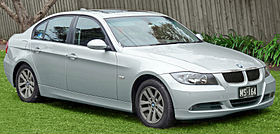
BMW 3-Series (E90)
Manufacturer BMW
Production December 2004 – October 2011
Model years 2006 – 2011
Assembly Leipzig, Germany
Munich, Germany
Toluca, Mexico
Jakarta, Indonesia (Gaya Motor) (since 2011)
Regensburg, Germany
Pretoria, South Africa
6th of October City, Egypt[3]
Kaliningrad, Russia
Shenyang, China
Chennai, India[6] (CKD)
Selangor, Malaysia
Predecessor BMW E46
Successor BMW F30
Class Compact executive car
Body style 2-door coupé (BMW E92)
2-door convertible (BMW E93)
4-door saloon (BMW E90)
5-door touring (BMW E91)
Layout Front engine, rear-wheel drive / all-wheel drive
Engine 1.6L I4; 2.0L I4; 2.5L I6; 3.0L I6; 3.0L Twin-Turbo I6; 4.0L V8; 2.0L Diesel I4; 3.0L Diesel I6; 3.0L Twin-Turbo Diesel I6
Transmission 6-speed manual
6-speed automatic
Wheelbase 2,761 mm (108.7 in)
Length Touring: 4,526 mm (178.2 in)
Convertible: 4,587 mm (180.6 in)
2007–2010 Coupe: 181.1 in (4,600 mm)
2011– Coupe: 181.9 in (4,620 mm)
saloon: 4,526 mm (178.2 in)
Width Touring: 1,816 mm (71.5 in)
Convertible & Coupe: 1,783 mm (70.2 in)
Height 2009– Touring: 55.8 in (1,417 mm)
2006–08 Touring: 1,455 mm (57.3 in)
Convertible: 1,384 mm (54.5 in)
328i Coupe: 1,374 mm (54.1 in)
328xi Coupe: 1,394 mm (54.9 in)
335i Coupe: 1,377 mm (54.2 in)
i saloon: 1,420 mm (55.9 in)
xi saloon: 1,425 mm (56.1 in)
Related BMW M3
BMW X3
Designer(s) Joji Nagashima(2002)
Touring (E91)
The E91 station wagon is known as the 3 Series Touring or Sports Wagon. It features an optional panoramic sunroof, which stretches far enough for passengers in the rear to enjoy. Unladen weight of 328i is 3527 lbs (as stated in 3 Series SportWagon Brochure).
Unlike the alternative body styles, there was no high-performance M3 variant of the E91. Trim levels otherwise followed the E90 sedan closely. These included the next highest-performance trim, the 335i, with its turbocharged petrol I6 engine. Other powertrains used a range of petrol and diesel I6 and I4 engines, paired with RWD and/or xDrive AWD. Markets such as the United States and Canada, however, offered but a small subset of their already limited E90 trims. In these two markets, only the 325xi with AWD was available prior to 2007,[24] and only the 328i in RWD and xDrive AWD forms was offered from 2007 onwards.
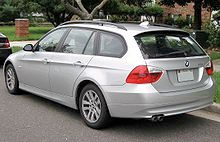
Pre-facelift BMW 328i (E91), US
Coupé (E92)


Pre-facelift BMW 325i (E92), Australia
Pre-facelift BMW 335i (E92), Australia
The two-door iteration of the 3-Series became available in August 2006 as a 2007 model, being released one year after the saloon. It is the second BMW coupe offered with BMW xDrive, BMW's moniker for all-wheel-drive, after the 325ix of the late 1980s and early 1990s. The E92 is available in the 320i, 323i, 325i, 325xi, 328i, 328xi, 330i, 330xi, 335i, 335is, 335xi, 320d, 325d, 330d, 335d and 330xd trims (availability of certain models depends on region).
The coupé's body is its own design and no longer derived from the saloon with two fewer doors like its predecessors. Almost every exterior design cue is different from the sedan counterpart. Head lamps are shaped more narrow, kidney grills are more round, and the tail lamps are much wider. The roofline is much lower, including the trunk and rear end appears to be “squished” down sitting next to an E90 Sedan. Bumpers and side skirts are unique. The hood is slightly longer; so are the doors. The shape of the driver and passenger windows are shorter and wider; rear occupants are treated to a much smaller side window. Also the rear windshield appears shorter and has less visibility. Most wheel designs are different from the sedan and the coupe. Selections include 17” for the base models, 18” with a sports package, and optional 19” wheels. The interior shares the same dashboard, center consol, and front bucket seats as the sedan. A small metallic strip outlines the steering wheel. Metallic materials of the door handle, steering wheel trim, radio knob bezzels, A/C vents, and automatic transmission shift knobs are chrome in the coupé as opposed to aluminum in the sedan. The door panels are much longer, it seats two passengers in the rear instead of the three-person bench, and also includes a rear center consol tray. A "Creamy" Beige leather interior with a much lighter tone is offered in the coupe instead of the standard Beige color as seen in the sedan. The coupé also features frameless doors like its E46 predecessor. There are also retractable arms that extend from the B-pillar to hand the seat belt to the driver and/or passenger when the key fob is in the ignition and the door is closed. Compared to the E90 saloon, an E92 is generally $3000 USD more expensive; E92s also have more features such as standard Xenon HID headlights.
The M3 high-performance variant of the coupe debuted in 2007 at the Geneva Auto Show. It features a V8 engine for the first time in a 3-series, the S65B40, which is derived from the BMW S85 V10 that powers the E60 M5.
The BMW M3 GTS is high-performance variant of M3 coupe and it debuted in November 2009. It features a modified 4.4 M3 V8 engine with 450 bhp (336 kW; 456 PS). In addition to engine upgrade it has improved brakes with 6 pot front brake calipers, new sports suspension, light weight body and adjustable rear spoiler.
Convertible (E93)
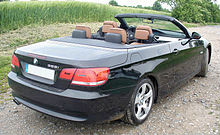
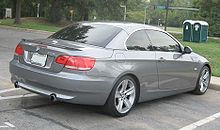
Pre-facelift BMW 325i (E93) with roof retracted, Germany
Pre-facelift BMW 335i (E93) with roof unretracted, US
The 3 Series convertible is also known as the coupé cabriolet on BMW's website. It is the first model in BMW's lineup with a 3-piece folding aluminum hardtop roof, as previous (E46 3 Series) and existing convertibles (E63 6 Series, E85 Z4) were soft-tops. The new convertible is also the centre of many new technological advancements for BMW as well as the recipient of many existing safety and performance technologies that have been improved upon for the new model. The E92 3 Series convertible improves upon BMW's "Comfort Access" option, by allowing the user to completely raise and lower the folding roof by simply pressing and holding the respective buttons on the key fob. Overall visibility is up 38 percent, thanks to the side windows which are 30 percent larger, compared to the E43 3 Series Cabriolet.
When first offered, the 3 Series convertible was the only retractable hardtop alongside the Mercedes-Benz SLK-Class (a 2-seater roadster) in that price category, with the 3 Series being the only one with a 2+2 seating configuration. Other manufacturers have since produced retractable hardtop convertibles in the compact executive (entry-level luxury) car segment, such as the Lexus IS C and Infiniti G37 convertible, to compete with the BMW 3 Series. Although the BMW 3 Series convertible is considerably more expensive than its direct rivals, it has been considered by reviewers to be better engineered, in regards to passenger/trunk space (even with the roof open) and driving dynamics (particularly weight and chassis rigidity).
The M3 high-performance variant of the convertible debuted in 2008, sharing the same powertrain as the M3 saloon (which also debuted for 2008) and coupe (released in 2007). Its closest competitor at the time was the Mercedes-Benz CLK63 AMG cabriolet.
In March 2010, the convertible along with the E92 coupe received a refresh (BMW internally called "LCI" or Life Cycle Impulse) for the 2011 model year. The updates focus on modifications to the front and rear bumpers, headlight design, wider kidney grille, new colors, new leather and trim color options, LED Corona running lights ("Angel Eyes"), and LED taillights. The 335i's N54 twin-turbo inline 6 was replaced by the N55 twin-scroll single turbo inline 6 engine as in all 3 series models. Like its coupe sibling, the convertible also received a higher-performance 335is trim, sharing the modified version of the twin turbo N54 engine with increased output, and the options of the 6-speed manual or DCT double clutch transmission options. The 335is convertible has foglamps which the 335is coupe lacks in favor of a larger air intake dam.
Home | Contact Us | Blog | Email: mill1546@comcast.net | Contact Paul Miller: 678-978-6995